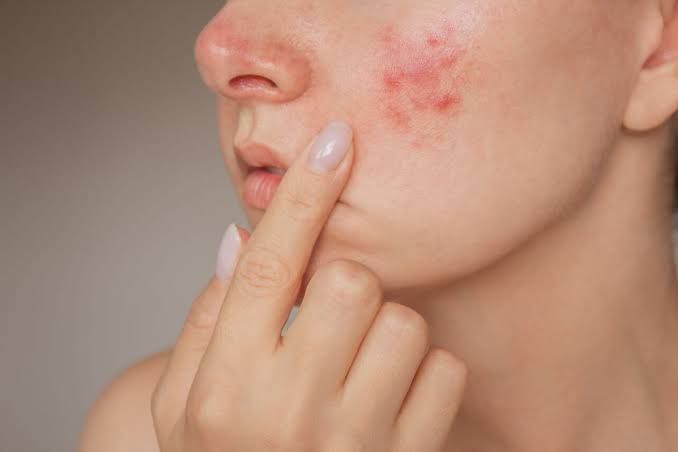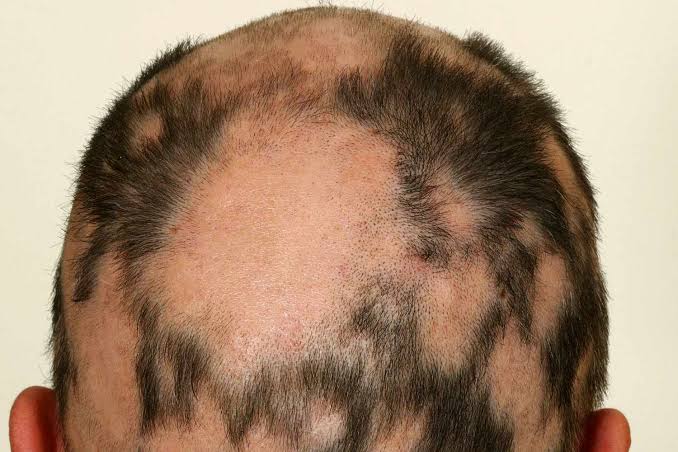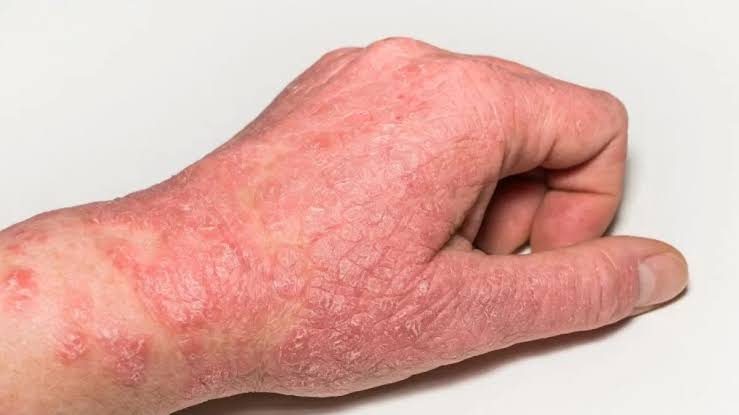
The Pathogenesis of Acne and Rosacea
Overview of Acne Pathogenesis
Acne vulgaris is primarily a chronic inflammatory disease affecting the pilosebaceous unit, which includes hair follicles and sebaceous glands. The pathogenesis of acne is multifactorial, involving several key mechanisms:
- Sebum Production: Increased sebum production is a hallmark of acne. This hypersecretion is often influenced by hormonal changes, particularly during puberty when androgens stimulate sebaceous gland activity.
- Keratinocyte Hyperproliferation: The abnormal proliferation of keratinocytes (skin cells) leads to the clogging of hair follicles. This process creates an environment conducive to bacterial growth.
- Bacterial Colonization: The skin bacterium Propionibacterium acnes plays a significant role in acne development. It thrives in the anaerobic environment of clogged pores, leading to inflammation.
- Inflammation: The presence of bacteria triggers an immune response, resulting in inflammation characterized by redness, swelling, and pus formation.
- Genetic Factors: Genetic predisposition also contributes to acne severity and susceptibility, indicating that familial patterns may influence individual risk.
- Environmental Factors: External factors such as diet, stress, and exposure to certain chemicals can exacerbate acne symptoms.
Overview of Rosacea Pathogenesis
Rosacea is a chronic inflammatory condition that primarily affects the facial skin and is characterized by flushing, persistent erythema (redness), papules, pustules, and telangiectasia (visible blood vessels). Its pathogenesis involves several overlapping mechanisms:
- Vasoactive Mechanisms: Dysregulation of vascular responses leads to increased blood flow and flushing episodes. This may be triggered by environmental factors such as temperature changes or spicy foods.
- Neurocutaneous Mechanisms: There is evidence suggesting that neurogenic inflammation plays a role in rosacea’s pathophysiology. Nerve fibers in the skin may become activated and contribute to inflammation.
- Immune Dysregulation: An abnormal immune response has been implicated in rosacea, with increased levels of certain inflammatory mediators observed in affected individuals.
- Microbiome Alterations: Changes in the skin microbiome may also play a role in rosacea development. For example, an overgrowth of Demodex mites has been associated with rosacea flare-ups.
- Genetic Predisposition: Similar to acne, genetic factors may influence susceptibility to rosacea, although specific genes have yet to be definitively identified.
- Overlap with Acne: Many patients exhibit both conditions simultaneously (acne-rosacea overlap), complicating diagnosis and treatment due to shared clinical features like papules and pustules.
In summary, both acne and rosacea share common pathways involving inflammation and immune dysregulation but differ significantly in their primary triggers and manifestations. Advances in understanding these mechanisms are expected to lead to improved therapeutic strategies for managing these conditions effectively.
Diagnosis of Acne and Rosacea
Definition of Comedones and Other Clinical Presentations
Comedones are a type of acne lesion that occurs when hair follicles become clogged with oil (sebum), dead skin cells, and bacteria. They can be classified into two main types:
- Open Comedones (Blackheads): These are characterized by a dark appearance at the surface due to oxidation of melanin in the sebum.
- Closed Comedones (Whiteheads): These appear as small, flesh-colored bumps under the skin, where the follicle is completely blocked.
Other clinical presentations associated with acne include:
- Papules: Small, raised red bumps that may be tender.
- Pustules: Similar to papules but filled with pus, often appearing white or yellow at the tip.
- Nodules: Larger, painful lumps beneath the skin that can persist for weeks or months.
- Cysts: Deep, painful lesions filled with pus that can cause scarring.
In contrast, rosacea is characterized by facial redness and visible blood vessels. Other clinical presentations include:
- Erythema: Persistent redness of the central face.
- Telangiectasia: Small dilated blood vessels visible on the skin’s surface.
- Papulopustular rosacea: Resembles acne with red bumps and pustules but without comedones.
- Phymatous changes: Thickening of the skin, particularly on the nose (rhinophyma).
- Ocular rosacea: Involves eye irritation and redness.
Variants of Acne
Acne can present in several variants, including:
- Acne Vulgaris: The most common form, characterized by comedones, papules, pustules, nodules, and cysts.
- Acne Conglobata: A severe form involving interconnected nodules and abscesses; it often leads to significant scarring.
- Acne Fulminans: An acute variant presenting with sudden onset of severe inflammatory nodules and systemic symptoms like fever; it is rare but serious.
- Hormonal Acne: Often linked to hormonal fluctuations (e.g., during menstruation) and typically presents along the jawline.
Subtypes of Rosacea
Rosacea has four recognized subtypes:
- Subtype 1 (Erythematotelangiectatic Rosacea): Characterized by flushing and persistent redness along with visible blood vessels.
- Subtype 2 (Papulopustular Rosacea): Features red bumps and pustules resembling acne but without comedones.
- Subtype 3 (Phymatous Rosacea): Involves thickened skin; rhinophyma is a common manifestation in men.
- Subtype 4 (Ocular Rosacea): Affects the eyes causing dryness, irritation, and potential vision problems.
Risk Factors for Acne
Several risk factors contribute to the development of acne:
- Hormonal changes during puberty or menstrual cycles
- Excessive sebum production
- Bacterial colonization by Propionibacterium acnes
- Certain medications (e.g., corticosteroids)
- Diet high in refined sugars or dairy products
- Stress
Genetic predisposition also plays a significant role in susceptibility to acne.
Risk Factors for Rosacea
The risk factors for rosacea include:
- Fair skin types are more prone to developing rosacea.
- Age; it commonly affects adults aged 30 to 50 years old.
- Family history of rosacea or other inflammatory conditions
- Environmental triggers such as sun exposure, hot weather, wind, spicy foods, alcohol consumption, and stress.
Certain lifestyle factors may exacerbate symptoms.
Complications Associated with Acne
Complications from untreated or severe acne can include:
- Scarring (atrophic scars or hypertrophic scars)
- Psychological effects such as anxiety or depression
- Hyperpigmentation post-inflammatory changes
Severe cases may lead to significant emotional distress affecting quality of life.
Complications Associated with Rosacea
Complications related to rosacea may involve:
- Skin thickening leading to disfigurement
- Ocular complications if left untreated can result in vision problems
- Social stigma due to visible facial changes
Both conditions require appropriate management strategies tailored to individual needs to prevent complications.
Utilizing Clinical Data, Clinical Examination Findings, and Bed-Side Diagnostics in Differential Diagnosis of Acne and Rosacea
Acne and rosacea are both common skin conditions that can present with similar symptoms, making differential diagnosis crucial for effective management. Understanding the clinical data, examination findings, and bedside diagnostics is essential for distinguishing between these two conditions.
Clinical Data
- Patient History:
- Acne: Typically affects adolescents and young adults but can persist into adulthood. Key factors include hormonal changes (e.g., puberty), family history of acne, use of comedogenic products, and lifestyle factors such as diet.
- Rosacea: More common in adults aged 30-50, particularly those with fair skin. Triggers may include sun exposure, stress, hot beverages, spicy foods, and alcohol consumption.
- Symptom Duration and Onset:
- Acne lesions often appear in cycles related to hormonal fluctuations.
- Rosacea symptoms may develop gradually over time with episodes of flushing or persistent redness.
- Associated Symptoms:
- Acne may be associated with oily skin or seborrhea.
- Rosacea often includes ocular symptoms such as dryness or irritation of the eyes (ocular rosacea).
Clinical Examination Findings
- Lesion Types:
- Acne: Characterized by comedones (open and closed), papules, pustules, nodules, and cysts primarily located on the face, back, and shoulders.
- Rosacea: Presents with erythema (flushing), telangiectasia (visible blood vessels), papules, pustules that resemble acne but typically lack comedones. The distribution is usually central on the face (cheeks, nose).
- Skin Texture Changes:
- Acne can lead to scarring or post-inflammatory hyperpigmentation.
- Rosacea may cause thickening of the skin (rhinophyma) particularly in advanced cases.
- Flushing Patterns:
- In rosacea patients often exhibit a pattern of flushing triggered by environmental factors or emotional stress.
- Distribution of Lesions:
- Acne lesions are more likely to occur on areas rich in sebaceous glands.
- Rosacea lesions are predominantly found on the central face without involvement of the forehead or scalp.
Bed-Side Diagnostics
- Dermatoscopy:
- This tool can help visualize vascular patterns in rosacea that are not visible to the naked eye. For example, dilated blood vessels may indicate rosacea rather than acne.
- Skin Biopsy (if necessary):
- A biopsy can help differentiate between inflammatory conditions if there is uncertainty; however, it is rarely needed for straightforward cases.
- Response to Treatment Trials:
- Observing how lesions respond to topical treatments can also aid diagnosis; for instance, topical retinoids are effective for acne but may exacerbate rosacea.
- Laboratory Tests (if indicated):
- Hormonal evaluations might be considered if there’s suspicion of underlying endocrine disorders contributing to acne.
- Assessment Tools/Questionnaires:
- Utilizing standardized questionnaires like the Patient Health Questionnaire-9 (PHQ-9) can help assess psychological impacts which might differ between patients suffering from acne versus those with rosacea.
- Photographic Documentation:
- Taking before-and-after photos during treatment trials helps track progression or improvement over time.
By integrating clinical data from patient history with thorough clinical examination findings and utilizing bedside diagnostic tools effectively, healthcare providers can accurately differentiate between acne and rosacea leading to appropriate management strategies tailored to each condition’s unique characteristics.
Assessing the Severity of Acne and Rosacea
To assess the severity of both acne and rosacea, dermatologists typically utilize a combination of clinical evaluations, standardized scoring systems, and patient-reported outcomes. This multifaceted approach allows for a comprehensive understanding of the conditions’ impact on patients’ lives and their physical manifestations.
1. Clinical Evaluation
The first step in assessing acne and rosacea severity involves a thorough clinical evaluation by a dermatologist. This includes:
- Visual Inspection: Dermatologists examine the skin for various lesions associated with acne (such as comedones, papules, pustules, nodules, and cysts) and rosacea (including erythema, telangiectasia, papules, and pustules).
- History Taking: A detailed medical history is taken to understand the duration of symptoms, previous treatments, family history of skin conditions, and any triggers that may exacerbate the conditions.
2. Standardized Scoring Systems
Several standardized scoring systems have been developed to quantify the severity of acne and rosacea:
- Acne Severity Scoring Systems:
- The Global Acne Grading System (GAGS) evaluates acne based on lesion counts in different facial areas.
- The Acne Severity Index (ASI) provides a numerical score based on the type and number of lesions present.
- Rosacea Severity Scoring Systems:
- The Rosacea Quality of Life Index (RQoL) assesses how rosacea affects patients’ quality of life.
- The National Rosacea Society (NRS) Classification categorizes rosacea into subtypes based on clinical features.
These scoring systems help in tracking disease progression or improvement over time and can guide treatment decisions.
3. Patient-Reported Outcomes
Patient-reported outcome measures are crucial for understanding how acne and rosacea affect individuals personally. These include:
- Dermatology Life Quality Index (DLQI): This tool assesses how skin conditions impact daily life across various domains such as work, social activities, personal relationships, and emotional well-being.
- Specific Questionnaires: Patients may be asked about their experiences with symptoms like pain or itching associated with their condition.
4. Laboratory Tests
In some cases, laboratory tests may be used to rule out other conditions or assess underlying factors contributing to acne or rosacea severity:
- For example, hormonal assessments might be conducted if there is suspicion of hormonal imbalances contributing to severe acne.
5. Real-World Evidence
Recent studies have highlighted the importance of real-world evidence in assessing the impact of external factors on these conditions. For instance:
- Research has shown that wearing masks during the COVID-19 pandemic has led to increased reports of “maskne” (acne caused by mask-wearing) and exacerbated symptoms in individuals with existing rosacea due to changes in skin microenvironment such as increased humidity and sebum production.
By integrating these methods—clinical evaluations, standardized scoring systems, patient-reported outcomes, laboratory tests where necessary—dermatologists can effectively assess the severity of both acne and rosacea. This comprehensive assessment is essential for tailoring appropriate treatment strategies that address both physical symptoms and quality-of-life concerns.
Management of Acne and Rosacea: Principles and Treatment-Related Side Effects
Understanding Acne Management
Acne is a common skin condition characterized by the presence of comedones, papules, pustules, and sometimes cysts. The management of acne involves several principles:
- Assessment and Diagnosis: Accurate diagnosis is crucial for effective treatment. Dermatologists assess the severity of acne (mild, moderate, or severe) and consider factors such as age, skin type, and any underlying conditions.
- Topical Treatments:
- Benzoyl Peroxide: An antimicrobial agent that reduces bacteria on the skin and helps prevent clogged pores. Common side effects include dryness, irritation, and peeling.
- Retinoids (e.g., Tretinoin): Promote cell turnover and prevent clogged pores. Side effects may include redness, peeling, and increased sensitivity to sunlight.
- Salicylic Acid: A beta-hydroxy acid that helps exfoliate the skin and unclog pores. Potential side effects include dryness and irritation.
- Oral Medications:
- Antibiotics (e.g., Doxycycline): Reduce inflammation and bacterial load in moderate to severe cases. Side effects can include gastrointestinal upset, photosensitivity, and potential antibiotic resistance.
- Hormonal Treatments (e.g., Oral Contraceptives): Can be effective in females by regulating hormones that contribute to acne. Side effects may include nausea, weight gain, or mood changes.
- Isotretinoin: A potent retinoid used for severe acne resistant to other treatments. It has significant side effects including teratogenicity (risk of birth defects), dry mucous membranes, liver enzyme elevation, and potential mood changes.
- Lifestyle Modifications: Recommendations may include a gentle skincare routine, avoiding known triggers (like certain foods or stress), and maintaining a healthy diet.
- Follow-Up Care: Regular follow-up with a dermatologist is essential to monitor treatment efficacy and adjust therapies as needed.
Understanding Rosacea Management
Rosacea is a chronic inflammatory condition primarily affecting the face characterized by flushing, persistent redness, visible blood vessels, papules, and pustules.
- Assessment and Diagnosis: Similar to acne management but focused on identifying triggers such as sun exposure, hot beverages, spicy foods, or stress.
- Topical Treatments:
- Metronidazole Cream/Gel: An anti-inflammatory agent that reduces redness and lesions associated with rosacea; side effects can include burning or stinging at application sites.
- Azelaic Acid: Helps reduce inflammation and clear up bumps; possible side effects are mild irritation or dryness.
- Ivermectin Cream: Targets inflammatory lesions; side effects may include application site reactions like itching or burning.
- Oral Medications:
- Antibiotics (e.g., Tetracycline): Used for their anti-inflammatory properties rather than antibacterial; side effects are similar to those noted in acne treatment.
- Isotretinoin: In some severe cases of rosacea where other treatments fail; carries similar risks as noted above for acne management.
- Laser Therapy: For vascular lesions or persistent redness; potential side effects can include temporary swelling or bruising at the treatment site.
- Lifestyle Modifications: Identifying personal triggers is key; patients are advised to avoid known irritants like harsh skincare products or extreme temperatures.
- Ongoing Care: Regular dermatological evaluations help manage flare-ups effectively.
In both conditions—acne and rosacea—patient education about adherence to treatment regimens is vital for long-term management success.
The most important treatment-related side effects vary between medications but generally involve skin irritation for topical agents and systemic issues like gastrointestinal problems for oral medications.
Overall management strategies should be individualized based on patient needs while considering potential side effects to optimize therapeutic outcomes effectively.







